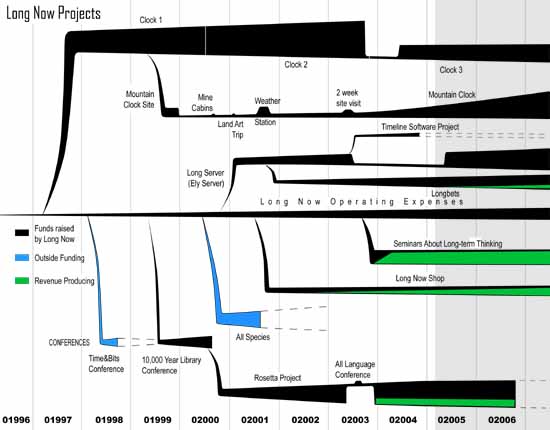![]()
THE FOUNDATION
The Long Now Foundation was established in 01996* to develop the Clock and "Library" projects, as well as to become the seed of a very long term cultural institution. The Long Now Foundation hopes to provide counterpoint to todays "faster/cheaper" mind set and promote "slower/better" thinking. We hope to creatively foster responsibility in the framework of the next 10,000 years.
Below is a "time tree" chart of the various projects
Long Now is doing or incubating in some form. The thickness of the line represents
the relative amounts of funding and effort.
 |
The projects represented on the Time Tree from top to bottom:
- The 10,000 year Clock
- Long Mountain, the desert Clock
site
- Environmental Advisors
- Mining cabin restoration (on the Long Now property in NV)
- Land art trip (Roden Crater, Star Axis, Lightning Field, Acoma Pueblo, Trinity)
- Remote weather station (installed July 02001)
- Ely server (long term digital storage and research project:
- Longbets
- Timeline Software Project (open source long term timeline tool)
- Seminars About Long Term Thinking
- Long Now Shop
- All Species Foundation
- Time & Bits Managing Digital Continuity Conference
- 10,000 Year Library Conference
- The Rosetta Project
- Longmail
THE CLOCK AND LIBRARY PROJECTS
Civilization is revving itself into a pathologically short attention span. The trend might be coming from the acceleration of technology, the short-horizon perspective of market-driven economics, the next-election perspective of democracies, or the distractions of personal multi-tasking. All are on the increase. Some sort of balancing corrective to the short-sightedness is needed-some mechanism or myth which encourages the long view and the taking of long-term responsibility, where 'long-term' is measured at least in centuries. Long Now proposes both a mechanism and a myth. It began with an observation and idea by computer scientist Daniel Hillis:
"When I was a child, people used to talk about what would happen by the year 2000. For the next thirty years they kept talking about
what would happen by the year 2000, and now no one mentions a future date at all. The future has been shrinking by one year per year for my entire life. I think it is time for us to start a long-term project that gets people thinking past the mental barrier of an ever-shortening future. I would like to propose a large (think Stonehenge) mechanical clock, powered by seasonal temperature changes. It ticks once a year, bongs once a century, and the cuckoo comes out every millennium."
Such a clock, if sufficiently impressive and well engineered, would embody
deep time for people. It should be charismatic to visit, interesting to think
about, and famous enough to become iconic in the public discourse. Ideally,
it would do for thinking about time what the photographs of Earth from space
have done for thinking about the environment. Such icons reframe the way people
think.
Hillis, who developed the 'massive parallel' architecture of the current generation of supercomputers, devised the mechanical design of the Clock and is now building the second prototype (the first prototype is on display in London at the Science Museum). The Clock's works consist of a binary digital-mechanical system which is so accurate and revolutionary that we have patented several of its elements.(With 32 bits of accuracy it has precision equal to one day in 20,000 years, and it self-corrects by 'phase-locking' to the noon Sun.) For the way the eventual Clock is experienced (its size, structure, etc.), we expect to keep proliferating design ideas for a while. In 01999 Long Now purchased part of a mountain in eastern Nevada whose high white limestone cliffs may make an ideal site for the ultimate 10,000-year Clock. In the meantime Danny Hillis and Alexander Rose continue to experiment with ever-larger prototype Clocks-the current one may be 20 feet high.
Long Now added a "Library" dimension with the realization of
the need for content to go along with the long-term context provided by the
Clock-a library of the deep future, for the deep future. In a sense every
library is part of the 10,000-year Library, so Long Now is developing tools
(such as the Rosetta Disk and the Long Server) that may provide inspiration
and utility to the whole community of librarians and archivists. The Long
Bets project-whose purpose is improving the quality of long-term thinking
by making predictions accountable-is also Library-related.
The point is to explore whatever may be helpful for thinking, understanding,
and acting responsibly over long periods of time.
-Stewart Brand
Updated March of 02002
* The Long Now Foundation uses five digit dates, the extra
zero is to solve the deca-millennium bug which will come into effect in about
8,000 years.